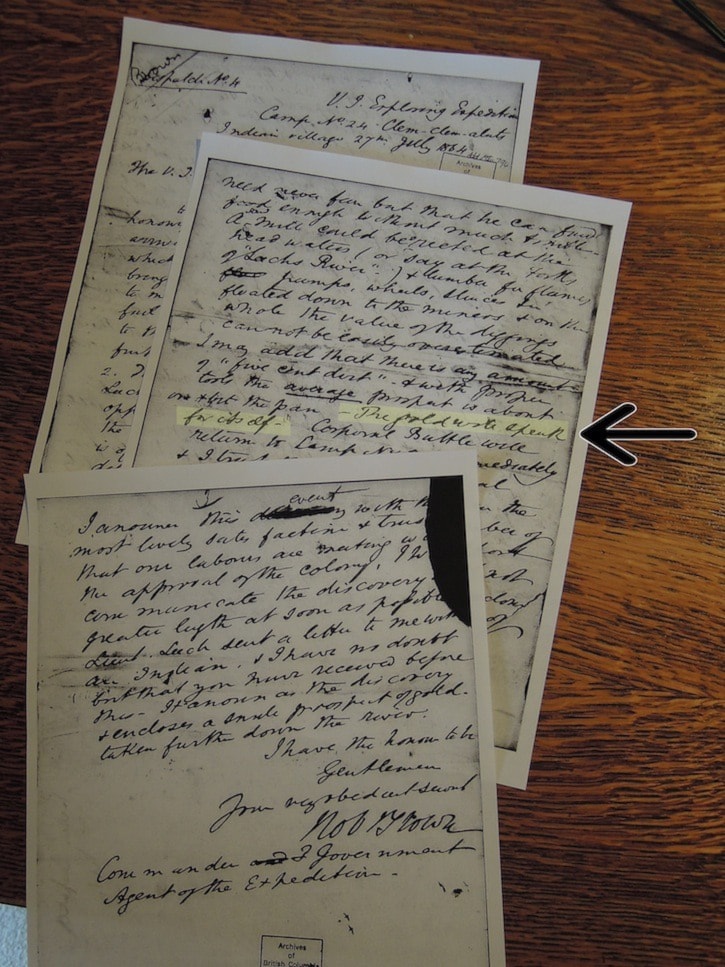Part II
Britt Santowski
Sooke News Mirror
Last week, we looked at the history of Sooke’s gold rush and examined the origins of expedition leader Peter Johm Leech’s famously -attributed quote, “The gold will speak for itself.” This week, we look at how the famous quote became tied to Leech and take a closer look at John Foley.
Between the delivery of that famous 1928 BCHA speech by the BCHA president and 1965, there was not much available from which to draw a different conclusion regarding the origins of the quote. If the president John Hosie attributed the quote to Leech, then it must be so. There were only a few letters available from Brown, none of them containing the quote.
Then, sometime in the 60’s, noted van den Berk, the BC archives stumbled across a pile of documents that included the journals of the other expedition members, committee minutes and letters from the actual expedition.
Almost a century after the original expedition, other documents came to light.
“(They) belonged to a guy — I believe in Montreal — who received it from a relative of Brown’s. The BC Archives acquired all these documents from him,” said van den Berk.
They have been a part of the BC Archive since, but the version featuring Leech had already been installed in the lore. And each subsequent re-telling of the 1928 speech served to solidify it further.
“If you go back to the original documents of 1864 and all the journals of the members themselves which give a very accurate (account) of what happened (in) those days,” said van den Berk, “they give a different story.”
According to these newly unearthed documents, the person responsible for finding the gold was Foley, not Leech. Van den Berk said there are at least six different documents that attributed it to Foley.
Lydon’s book also hints of this possibility, as he too notes that Leech was not present on the day the gold was found.
“Four members of the expedition, including John Foley, were asked to return to that river and explore it’s origins and possibility of gold.” Crediting Leech, said Lydon, was a result of his being the expedition leader after Brown had departed to Victoria.
Lydon also records a “great disagreement amongst the men,” in which Leech wanted to carry on to Cowichan Bay.
According to van den Berk, Foley wanted to stay in Leechtown while Leech wanted to press on. Van den Berk asserted that it was Foley’s insistence that eventually caused a return to Leechtown, that in turn precipitated the boom.
Foley fell out of favour when he drew a knife on a party member by the name of Macdonald after the gold was discovered on the Leech River. He was immediately — albeit quietly — discharged from the expedition by Brown, with honour and pay intact.
Lydon noted this dispute created a significant amount of tension between Brown and Foley.
Foley returned to Victoria and, as Van den Berk writes on his website “placed an advertisement in the newspapers, stating he can be found in Sooke to show miners the shortest way and offering his services for the new El Dorado.”
The ad, available on the leechtownhistory.ca website, closes with Foley’s July 30, 1864 promise, “I will select a spot in Sooke Harbor (sic), connecting with the trail leading direct to the mines, and will indicate the locality by the hoisting of a white flag with a Maltese Cross.”
The historical views offered up by both van den Berk and Lydon, in which each looks at one event through the lens of a different party member (Foley and Leech, respectively), are the beginnings of a closer look at the men who forged the wilderness to unearth gold here in the hills of Sooke.
On July 18, 2014, it will be exactly 150 years since the discovery of gold at Leechtown. A list of planned events, beginning in June, can be found at leechtownhistory.ca.
Lydon’s book can be purchased at the Sooke Region Museum, and you can follow the discoveries made by van den Berk on his website atleechtownhistory.ca.
Leechtown, located at the top of Sooke River, is accessible via the Galloping Goose trail that goes up to the Sooke Potholes. According to “The Official Guide” on GallopingGooseTrail.com, “Leechtown, an old mining town, lies on private land beyond the regional trail.” But, it forewarns, “Those expecting to view a quaint, ghost town will be disappointed. Though rich in history, much of Leechtown has disappeared, either overgrown with Scotch Broom or dismantled long ago.”
